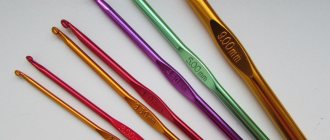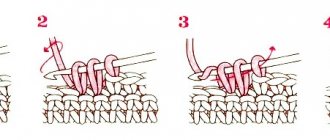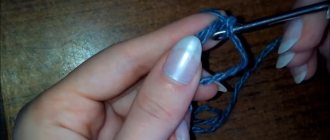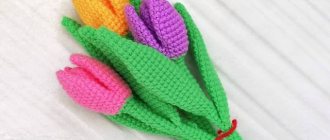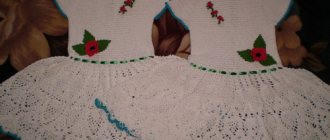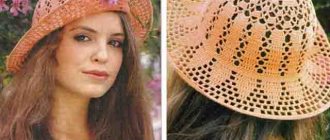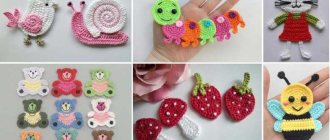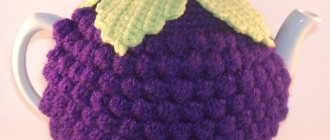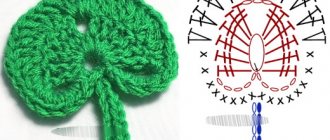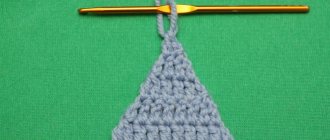Knitting booties for newborns, as a rule, attracts expectant mothers and grandmothers. Congratulations if you are one of them!
Even if you have never held a knitting tool in your hands before, today’s lesson will help you easily crochet booties for beginners with your own hands! Simple and original models with clear descriptions, videos, step-by-step instructions and photos will help you cope with this task perfectly!
Legend: p. – loop; V. n. - air loop; With. – column; With. without n. – single crochet; With. s n. – double crochet; p/s s n. – half double crochet; ss. – connecting column; R. - row.
The simplest crochet booties for your newborn. MK for beginners.
We will need:
- yarn (100% acrylic, 100 grams per 155 meters);
- cr. No. 5.
Size: from 1 month to 3 months.
Description
+ crochet 8 in. p.. 1 p.: 1 s. without n. in the 2nd paragraph from cr., 1 p. without n. in the next 5 p., 4 s. without n. in the last p., turn, knit along the chain in reverse order: 1 s. without n. in the next 7 stitches, connecting stitch in the 1st stitch of the row. 2 p.: 1 v. p., 2 p. without n. in the first 2 p., 1 s. without n. in the next 4 p., 2 p/s with n. in the next 5 p., 1 s. without n. in the next 4 p., 2 s. without n. in the last 2 p., connecting column in the 1st s. row. 3 p.: 1 v. p., 1 p. without n. in the next 10 p., 2 s. without n. in the next 6 p., 1 p. without n. in the next 10 p., ss in 1st s. row. 4 p.: 1 v. p., knit for the back segment of p. 1 s. without n. in each st., ss = 32 s.. 5 rubles: for both slices at once, 1 st. p., 1 p. without n. to the end, ss.. 6 p.: 1 v. p., 1 p. without n. in the next 10 p., (2 s. without n. knit together) x 6, 1 s. without n. in the next 10 p., ss.. 7 p.: 1 v. p., 1 p. without n. in the next 8 p., (2 s. without n. we knit together) x 5, 1 s. without n. in the next 8 p., ss.. 8 p.: 1 v. p., 1 p. without n. in the next 8 p., (2 s. without n. together) x 3, 1 s. without n. in next.. 7 p., ss.. 9 p.: 2 v. p., 1 s s n. to the end, ss. = 18 s. 10 rubles: 1 s. without n. in the first 8 p., 2 s. without n. in the next 3 p., 1 p. without n. in the next 7 p., ss.. 11 p.: ss. in every point..
We insert the ribbon into the holes between the posts and tie a bow. Simple crochet booties for beginners are ready!
Bootie soles
The soles of booties are always knitted according to the same principle, and small details depend on your skill. Only the size changes, so take measurements and use different formulas to calculate the number of air loops. For a sole 10.5x5.5 cm, a chain 5 cm long is suitable - this is 10 loops with a thin thread and a number 2 hook.
Work 2 more stitches and then work a tenth single crochet for a neat rounded turn. Knit all remaining stitches in a regular stitch, except for the last one. You need to knit 5 stitches into it to move to the other side. And then make 8 more similar columns in mirrors so that the part is symmetrical.
Photo: akamatra.com
Knit 2 stitches into the last loop, finish the circle and go up, and then make a stitch there, and two more in the second loop. Knit 4 stitches one at a time as usual, and after them 4 more double crochets, turn around and repeat again in a mirror image on the other side.
Then knit with regular stitches and add a loop only at the end. On the fourth row, add a couple of stitches in a wide place, and knit the fifth again just like that, without anything. If you need a different size and a different number of loops, recalculate the approximate proportions and adjust the shape as you go.
Crochet sandals for boys. Step-by-step master class.
We will need:
- yarn of the 1st and 2nd colors (60% acrylic, 40% nylon, 140 grams per 420 meters) and 3rd color, for tying (65% acrylic, 35% wool, 100 grams per 151 meters);
- cr. No. 3.75 for size 3 months, No. 4 for 6 months. and No. 4.25 for 9 months..
Size: 3, 6, 9 months.
Master Class
First sole
Thread 1st color. dial 12 v. p.. 1 p.: 3 s. without n. in the 2nd paragraph from cr., 1 p. without n. in the next 6 p., 1 p/s with n. in the next 3 p., 7 p/s with n. to the last point of the chain, turn the work over, knit 1 p/s from the back side. in the next 3 p., 1 p. without n. in the next 6 p., 2 s. without n. in the last p., ss. = 30 p.. 2 r.: 1 v. p., 1 p. without n. in the 1st paragraph, 2 p. without n. in the 2nd paragraph, 1 p. without n. in the next 6 p., 1 p/s with n. in the next 4 p., 2 p/s with n. in the next 3 p., 3 p/s with n. in the next p., 2 p/s with n. in the next 3 p., 1 p/s with n. in the next 4 p., 1 p. without n. in the next 6 p., 2 s. s n. in the next p., 1 p. s n. in the 1st paragraph of this row, ss. = 41 p.. 3 r.: 2 v. p., 2 p/s with n. in the 1st p., 1 p/s with n. in the next p., 2 p/s. s n. in the next p., 1 p/s with n. in the next 14 p., 2 p/s with n. in the next 7 p., 1 p/s with n. in the next 14 p., 2 p/s with n. in the next p., 1 p/s with n. in the next p., 2 p/s with n. in the next p., ss. = 52 p..
The basis
We connect n. 2nd color in the 5th p. after ss., knit for the body p/s 3rd p. soles. 1 p.: 3 v. p., 2 p. s n. in the same paragraph, 1 p. s n. in the next p., 2 p. s n. in the next p., 3 c. p., pass. 5 p. soles, 2 p. s n. in the next p, 1 s. s n. in the next..p., 3rd century. p., skip 4 p., 2 s. s n. in the next p., 1 p. s n. in the next..p., 6th century. p., skip 12 p., 1 s. s n. in the next p., 2 p. s n. in the next p., 3 c. p., skip 4 p., 1 s. s n. in the next p., 2 p. s n. in the next p., 3 c. p., skip 5 p., 2 s. s n. in the next p., 1 p. s n. in the next p., 2 p. s n. in the next p., turn the knitting. 2 p.: 2 v. p., 1 p/s with n. in the next 15 p., 3 p. without n. Prov. vm. (2 s. over the last 2 s. of the previous row and 1 s. above the first p. of the arch of 6 v. p.), 4 p/s with n. in an arch, 3 pp. without n. vm. (last of 6 v.p. and 2 next s.), 1 p/s with n. in the next 15 p., 4 v. p., ss.. Left strap
Let's move on using ss. behind the inner wall in the 11th point on the right side. 3 r.: + 13 c. p. for strap, 1 p/s with n. in the 5th point from the cr. (= p. for button), 1 p/s with n. in the next 7 p. straps, 3 p. b n. vm. (remaining sts of strap and first 2 sts of base), 1 sts without n. in the next 20 sts (knit towards the heel, then end opposite the thread connection on the left side).
Right strap
Let's move on using ss. behind the inner wall in the 15th point on the left side. 3 r.: + 13 c. p. for the strap, 1 p/s with n. in the 5th point from the cr. (= p. for button), 1 p/s with n. in the next 7 p. straps, 3 p. without n. vm. (the remaining p. straps and the first 2 p/s of the base), 1 p/s without n. in the next 20 p..
Harness
Thread 3rd color. we tie the toes, heel, top and strap with. without n., prov. 3 s each without n. vm. in each corner and 5 s. without n. in paragraph for buttons.
Second sole
We dial 12 v. p.n. 2nd color.. 1-3 pp.: as 1-3 pp. first sole. 4 rubles: ss. in a circle through the canvas of the 1st and 2nd soles together. Sew on the button and the boy’s sandals are ready!
Description and components of knitted booties for children
Making slippers for babies from yarn is a very painstaking task. After all, the finished item is very small, and its constituent elements are smaller.
Regardless of the chosen form, the finished product consists of 4 main parts:
- cuff;
- toe;
- side;
- sole.
- Making slippers for babies, as a rule, begins with the cuff. In most instances, this piece is knitted in the round using 1/1 rib. However, when performing some work, for example in the form of sneakers, craftswomen deviate from this rule and the upper zone is knitted with a gap.
In addition, the top is often the main focus. In this case, this element is knitted in a relief or openwork pattern, often using multi-colored threads.
The toe is the next detail of the tiny shoe. Depending on the chosen model, the toe can be either solid or sewn to the cuff.
It is this element that, as a rule, accounts for the main decor of knitted slippers. Often the toe is decorated with a braid pattern and other relief designs. In addition, sewn-on decorative elements are often used: beads, rhinestones, ribbons, pompoms, and other textile decor.
The toe typically accounts for approximately 40% of the cuff studs.
The edging of children's handmade shoes imitates the sole of a shoe. It is this detail that determines how well the finished item will sit on the leg.
For an ordinary child’s foot, without any special features, the height of the side is 1-1.5 centimeters, the strips are distributed according to the principle of 20% for the front and back zones, 30% for the side zones.
Regardless of the chosen shape and whether the border is solid or sewn on, it is always knitted in the round.
The design of this element is usually minimalist. Most needlewomen prefer to knit the border using garter stitch or elastic that imitates a textured sole.
The base of handmade booties also differs according to the principle of solidity or sewing.
So, solid outsoles with a side, as a rule, have a seam in the middle of the canvas. Sew-on - knitted in one piece.
Since a baby's foot is very tender and sensitive, booties with a sewn-on base knitted in one piece are preferable. If the selected model involves a solid sole with a side, then the seam should be made outward.
The design emphasis often falls on other parts of the product, so the bottom is usually knitted in garter stitch. It is rare to find works with a sole in a color contrasting with the main part of the shoe.
Original crocheted summer sandals for boys and girls. MK for beginners.
We will need:
- yarn (100% cotton, 100 grams per 155 meters) – 2 colors;
- cr. No. 5;
- 2 buttons.
Size: sandals are designed for a baby 3-6 (6-12) months.
Description (sandals for girls/boys 0-3 months)
Sole
We knit 2 pieces. color 1 and 2 pcs. color 2. 1st: 9th century. p., 3 p. without n. in the 2nd paragraph from cr., 1 p. without n. in the next 5 p., 1 p/s with n. in the next p. and 7 p/s with n. in the last p., turn the work over, continue on the other side of the chain, 1 p/s with n. in the next p., 1 p. without n. in the rest 5 p. = 22 p., do not connect, knit. in a spiral. 2 p.: 2 s. without n. in the 1st paragraph of the 1st row, 2 p. without n. in the next 2 p., 1 s. without n. in the next 7 p., 2 s. without n. in the next 5 p., 1 s. without n. in next 7 p. = 30 p.. 3 r.: (1 s. without n. in next p., 2 s. without n in next p.) x 3, 1 p. without n. in the next 7 p., (1 s. without n. in the next p., 2 s. without n. in the next p.) x 5, 1 p. without n. in the next 7 p., ss. = 38 p..
We connect two soles of different colors to each other using a s..
Track
We connect the thread of color. 1 at the end of the fingers (see photo 2), then according to the diagram. 1 p.: 1 v. p., 1 p. without n. in the next 27 sts, turn, leaving 11 sts unknitted = 27 sts. 2 rows: 1 st. p., 2 p. without n. together, 1 p. without n. in the next 11 p., 2 s. without n. vm., 1 s. without n. in the last 12 p. = 25 p., turn. 3 p.: 1 v. p., 2 p. without n. vm., 1 s. without n. in the next 10 p., 2 s. without n. vm., 1 s. without n. in the last 11 p. = 23 p., turn. 4 p.: 1 v. p., 1 p. without n. in the first 9 p., 1 p/s with n. in the next 5 p., 1 s. without n. in the last 9 p., turn = 23 p.. 5 p.: 1 in. p., 1 p. without n. in the first 3 p., knit. only for the right lobe, p. 1 ss. in the next 6 p., 1 p. without n. in the next 5 p., knit. only for the right lobe, p. 1 ss. in the next 6 p., 1 p. without n. in the last 3 p. = 23 p..
For the left bootie
We connect n. 2 from 1st r. bases of the stack on the left side (see photo 4), knitting. ss. up to the last river top of the foot, + 6 in. p. (button loop), ss. around the bootie until the 1st r. on the other side.
For the right bootie
As for the left one, only we make a hole for the button on the opposite side. Sew on the buttons.
Description (sandals for 6-12 months)
Sole
We knit 2 pieces. color 1 and 2 pcs. color 2. 1st: 10th century. p., 3 p. without n. in the 2nd paragraph from cr., 1 p. without n. in the next 5 p., 1 p/s with n. in the next 2 p. and 7 p/s with n. in the last p., turn over, continue on the other side of the chain, 1 p/s with n. in the next 2 p., 1 s. without n. in the last 5 p. = 24 p., do not connect. 2 p.: 2 p/s with n. in the 1st paragraph of the 1st row, 2 p/s with n. in the next 2 p., 1 p/s with n. in the next 8 p., 2 p/s with n. in the next 5 p., 1 p/s with n. in the next 8 p. = 32 p.. 3 p.: (1 s. without n. in the next p., 2 s. without n. in the next p.) x 3, 1 p. without n. in the next 8 p., (1 s. without n. in the next p., 2 s. without n. in the next p.) x 5, 1 p. without n. in the next 8 p., ss. = 40 p.. We connect two soles of different colors to each other using a ss..
Track
We connect the thread of color. 1 at the end of the fingers (see photo 2), then according to the diagram. 1 p.: 1 v. p., 1 p. without n. in the next 29 p., 11 p. not knitted. = 29 p.. 2 r.: 1 v. p., 2 p. without n. vm., 1 s. without n. in the next 12 p., 2 s. without n. vm., 1 s. without n. in 13 p. = 27 p.. 3 r.: 1 v. p., 2 p. without n. vm., 1 s. without n. in the next 11 p., 2 s. without n. vm., 1 s. without n. in 12 p. = 25 p.. 4 r.: 1 v. p., 1 p. without n. in each p. = 25 p.. 5 p.: 1 v. p., 1 p. without n. in the first 10 p., 1 p/s with n. in the next 5 p., 1 s. without n. in 10 p. = 25 p.. 6 p.: 1 v. p., 1 p. without n. in the lane 3 p., knit. only behind the front wall of paragraph 1 ss. in the next 7 p., 1 p. without n. in the next 5 p., knit. only behind the front wall of paragraph 1 ss. in the next 7 p., 1 p. without n. in the village 3 p. = 25 p..
For the left
Connection n. 2 in 1st row. base of the foot on the left side (see photo 4), ss. up to the village R. top of the foot, dial 6 v. p. (button hole), ss. around the slipper until the 1st r. on the other side.
For the right
As for the left one, only a hole for a button from 6 in. p. is done on the other side. Sew on buttons and booties for boys and girls are ready!
Winter version in the form of a boot
Warm functional booties can be knitted in the form of boots. The yarn should be chosen bulky, from wool or acrylic. The boot is knitted in the same way as classic booties. Only in this case it is necessary to make a higher boot.
Booties for beginners with a step-by-step description of crochet are suitable for both boys and girls.
To keep the child warm, the boot should be close to the leg. And to make it comfortable for mom to put on booties, the top of the boot should be either elastic or have a fastener.
Openwork slippers. MK.
We will need:
- yarn (100% cotton, 100 grams per 288 meters);
- cr. No. 2.
Size: for newborn.
Scheme
Trace - along the road. 1, toe - according to diagram. 2 and 4, heel – cx. 3.
Description
We knit a 12v chain. p., knit the foot according to c. 1. We tie the edge 4 r. With. without n. without increments and divide the number of stitches in half for the heel and toe.
We make 22 sts of heels 4 r. With. without n, then for the fastener we add an additional chain from c to one side. p. about 5 cm and tie it with. with n., leaving at the end a buttonhole for a button from 6 in. p.. According to cx. 2 we make a toe with a membrane and sew it to the insole. We do the second shoe in the same way.
Assembly
We thread the fasteners into the holes of the membranes and sew on the buttons.
How to crochet stylish moccasin booties?
Knitting moccasins is easy with the right yarn and crochet hook. Just follow simple rules and in just a few hours you can make a beautiful pair of booties. Measuring measures are very important points in the implementation of a product. Using a soft measuring tape, measurements are taken along the baby's leg.
Measurements
You will need to measure the width of the foot, the length of the child’s leg and the circumference of the elastic band. In three sizes it will be possible to make wonderful models.
Sample
The next step in the work is the sample. To select it, you should carefully study the model and peer into its patterns.
Determine the most common patterns that relate to measurements and make a sample using them . The sample is a small square canvas, which is made strictly according to the provided patterns of things. Knit a small number of loops and rows. But enough to determine how many loops and rows you get per 10 cm ruler.
Set of first crochet stitches
As a result, the master should get two numbers. This is the density of the knitting and it will then tell you how many stitches will need to be cast on, and how many rows the knitter will need to knit to get the desired size, according to the established leg measurements. Then, in detail about two adorable models of booties for children, which are made using simple crochet patterns.
Rainbow slippers. Master Class.
We will need:
- yarn (100% merino, 50 grams per 86 meters);
- cr. No. 2.5.
Description of the pattern
We dial 3 v. p., (pull out the thread from the 2nd p. from the edge, then from the 3rd, pull out the thread from the 1st p. p., pull out the thread from the back wall. from the next p. p. = 6 p. . on the edge, we knit all stitches in the middle) = first repeat, *(pull out 2 threads along the first repeat, 1 thread from the last knitted stitch of the previous repeat, 1 thread behind the back wall with the next 2 stitches = 6 p. on the edge, wire all p. vm.), repeat from *, ss..
This is shown more clearly in this video:
Baby booties made of fur
If the floors at home are cold, these booties are a real lifesaver. They don’t wash out like knitted ones, but they protect better from the cold. In addition, these booties are very light.
The material can be taken from rabbit or lamb fur, or even from your old sheepskin coat. You can sew fur booties using the pattern:
The main thing is to take into account the direction of the fur when cutting. Booties can be made with or without lining.
First, decide on the size and make blanks. Sew the sides. Sew the back to the heel, just try to sew it so that no folds form. Now you need to sew the center of the tongue to the center of the toe of the sole. Sew them from the corner to the point where you will place the ties.
Pierce the leather in several places for the lace. Insert the lace. Now you need to sew to the cape, while gathering the edges. These booties can be worn with the fur facing out or in, as you wish. If you decide to wear it with fur inside, you can also sew on a decorative edge for beauty.
Slippers-boots - description
Insole
+ 20th century p., in a ring. 1 p.: 1 p/s with n. in the 3rd paragraph from the cr., 1 p. s n. in the next 16 p., 4 p/s with n. in the last p., turn the work over, now continue on the other side of the chain, 1 s. s n. in the next 16 p., 1 p/s with n. in the last p., ss..
Change the color of the thread. 2 r. (only behind the back wall): 3 in. p., 1 p. s n. in the 1st paragraph, 2 p. s n. in the next 3 p., 1 p. s n. in the next 13 p., 2 p. s n. in the next 7 p., 1 p. s n. in the next 13 p., 2 p. s n. in the next 2 p., ss.
Change the color of the thread. 3 r. (only behind the back wall): ss. in the next p., 3 c. p., 2 p. s n. in the next 5 p., 1 s. s n. in the next 16 p., 2 p. s n. in the next 10 p., 1 s. s n. in the next 16 p., 2 p. s n. in the next 4 p., 1 p. s n. in the next p., ss. = 72 p..
Track
Change the color of the thread. We do 1 r. pattern = 36 repeats. 2 p.: 1 v. p., s. without n. (2 pp. for 1 repeat of the pattern of the previous row).
Replace n.. 1st row: with a pattern. 2 p.: 1 v. p., (2 s. without n. vm.) x 10, 1 s. without n. in next.. 36 p., (2 s. without n. vm.) x 8, ss. = 54 p..
Top
Change colors every row. 1 p.: 1 v. p., 1 p. without n. in the 1st paragraph, 1 p. without n. in the next 3 p., turn.. 2 p.: 1 in. p., ss. in the next With. piles, 2 p. without n. behind the rear Art. in the first p., 1 p. without n. for the back st. in each p., 2 p. without n. for the back st. in the last p., ss. in the next With. piles. 3 p.: 1 v. p., ss. in the next With. piles, 2 p. without n. for the front st. in the 1st paragraph, 1 p. without n. for the front st. in everything. p., 2 p. without n. for the front st. in the last paragraph, ss. in the next With. piles. Repeat 2-3 pp. until we get 11 s. in the r.. Connect without additions with. without n. until the 18th r..
For lace
3rd century p., prop. first 2 p., *1 s. s n. in the next p., 1st century p., prop. 1 p., repeat from *, 1 st. p., 1 p. s n. in the last p.. **Change color Sl. r.: pattern = 22 repeats. Sl. r.: 1 c. p., then connect with. without n. (2 pp. per 1 rap. pattern of the previous row), repeat. from ** more x 2.
Lace
Tie 40 in. p. in chain., 6 s. without n. in the 2nd paragraph from the cr.. Next 1 p. without n. in each p. (if you need a thin lace, make 1 dc in the remaining st.), 6 p. without n. in the last p., turn over and continue in the other direction, 1 s. without n. in each p., ss. Insert the lace and tie it into a bow.
Preparing for knitting: materials and tools
The choice of yarn depends on the style and seasonality of the booties.
When creating shoes for a small child, you should pay attention to natural yarn or hypoallergenic synthetics:
- If you need warm winter booties, then it is better to opt for soft wool . It should not “bite” or fluff too much in order to be comfortable and safe for the baby. It is worth considering that when crocheting the fabric is thicker than when knitting, so the yarn should not be too bulky. The optimal thickness is 200-400 m/100 g.
- Bulky synthetic yarn (for example, plush or imitating fur) has good “winter” properties Soft and cozy booties are made from baby acrylic.
- For light summer booties cotton-based yarn with low twist, with a thread thickness of 300-500 m/100 g, is suitable. Manufacturers also offer microfiber made from synthetic fibers with properties identical to cotton (for example, Diva yarn).
- For elegant openwork booties, the best option would be yarn with the addition of viscose or silk . This yarn itself looks decorative, and in an openwork pattern it enhances its beauty and elegance.
The hook can be selected based on the recommendations of the yarn manufacturer (usually they are indicated on the label). But each needlewoman has a different knitting density and tension of the thread in the work, so it is better to select a hook by testing it on a specific thread.
Bright crochet booties and boots. Master class for beginners.
We will need:
- cotton yarn of medium thickness (choose the thickness according to the density of the knitting);
- cr. No. 3.5;
- 4 buttons.
Size: 0-3 (3-6, 6-9) months.
Description
Sole
Green thread dial 11 (12, 14) p.. 1 r. (green): 2 p/s. s n. in the 2nd p. from cr., 1 p/s from n. in the next 8 (9, 11) p., 6 p/s with n. in the village p., turn over, then along the other side of the chain, 1 p/s with n. in the next 8 (9, 11) p., 2 p/s with n. in the village p., ss. = 26 (28, 32) p.. 2 r. (green): 2 p/s with n. in the first 2 p., 1 s. without n. in the next 5 (6, p., 1 p/s with n. in the next 3 p., 2 p. with n. in the next 6 p., 3 p/s with n. in the next 3 p., 1 s without n. in row 5 (6,
dial 11 (12, 14) p.. 1 r. (green): 2 p/s. s n. in the 2nd p. from cr., 1 p/s from n. in the next 8 (9, 11) p., 6 p/s with n. in the village p., turn over, then along the other side of the chain, 1 p/s with n. in the next 8 (9, 11) p., 2 p/s with n. in the village p., ss. = 26 (28, 32) p.. 2 r. (green): 2 p/s with n. in the first 2 p., 1 s. without n. in the next 5 (6, p., 1 p/s with n. in the next 3 p., 2 p. with n. in the next 6 p., 3 p/s with n. in the next 3 p., 1 s without n. in row 5 (6, p., 2 s. without n. in village 2 p., ss. = 36 (38, 42) p.. 3 p. (green): 1 p. with n. in the lane 2 p., 2 p/s without n. in the next 3 p., 1 p/s with n. in the next 5 (6,
p., 2 s. without n. in village 2 p., ss. = 36 (38, 42) p.. 3 p. (green): 1 p. with n. in the lane 2 p., 2 p/s without n. in the next 3 p., 1 p/s with n. in the next 5 (6, p., 1 p. with n. in the next 3 p., (2 s. with n. in next p., 1 s. with n. in next p.) x 6, 1 s. with n. in next 3 p., 1 p/s with n. in the next line. 5 (6,
p., 1 p. with n. in the next 3 p., (2 s. with n. in next p., 1 s. with n. in next p.) x 6, 1 s. with n. in next 3 p., 1 p/s with n. in the next line. 5 (6, p., 2 p/s with n. in the village. 3 p., ss. = 48 (50, 54) p..
p., 2 p/s with n. in the village. 3 p., ss. = 48 (50, 54) p..
Stopochka
1 rub. - With. only behind the back wall of the loops. 4 rub. (green): 1 c. p., knit 1 s. without n. behind the back wall in each p., ss. = 48 (50, 54) p.. Attach a light green thread. 5 rub. (light green): 1 c. p., 1 p. without n. in each p., ss.. 6 rub. (light green): 1 c. p., 1 p. without n. in each p., ss. 7 rub. (light green): 1 c. p., 1 p. without n. in each p., ss.. 8 rub. (green): 1 c. p., 1 p. without n. in the first 14 (15, 17) p., (2 s. without n. vm., 1 s. without n. in the next p.) x 7, 1 s. without n. in the next 13 (14, 16) p., ss. = 41 (43, 47) p.. 9 r. (light green): 1 c. p., 1 p. without n. in the lane 13 (14, 16) p., (2 s. without n. vm., 1 s. without n. in the next p.) x 5, 1 s. without n. in the next 13 (14, 16) p., ss. = 36 (38, 42) p.. 10 r. (green): 1 c. p., 1 p. without n. in the first p., 2 p. without n. vm., 1 s. without n. in the next 9 (10, 12) p., (2 p/s with n.vm.) x 2, (2 p/s with n. vm.) x 2, (2 p/s with n. vm.) x 2, 1 p. without n. in the next 9 (10, 12) p., 2 p. without n. vm., 1 s. without n. in the next p., ss. = 28 (30, 34) p.. 11 r. (light green): 1 c. p., 1 p. without n. in the first p., 2 p. without n. vm., 1 s. without n. in the next 9 (10, 12) p., (2 s. with n. vm.) x 2. 1 s. s n. in the next 9 (10, 12) p., 2 p. s n. vm., 1 s. without n. in the next p., ss. = 24 (26, 30) p..
Cuff
Next, the boots (left, etc.) are knitted symmetrically. Let's move on using ss. 7 p. from the center of the front towards the heel. Turn the knitting so that the next R. it was necessary to tie towards the heel. 12 rub. (green): 1 c. p., 1 p. without n. in the next 23 (25, 29) p., emb. 6th century p. into the chain, turning.. 13 r. (green): 1 p/s with n. in the 3rd p. from cr., 1 p/s from n. in each p.r., turning. = 27 (29, 33) p.. 14 r. (light green): 2 c. p., 1 p/s with n. in the rest p., turning.. 15 rub. (green): 2 c. p., 1 p/s with n. in the rest p., turning.. 16 r. (light green): 2 c. p., 1 p/s with n. in all points, turning.. 17 r. (green): 2 c. p., 1 p/s with n. all the way, turn.. 18 rub. (light green): 2 c. p., 1 p/s with n. all the way, turn.. Green no. we tie the cuffs with. without n. and sew 2 buttons through two layers of cuff.
Warm booties with buttons
You will need acrylic thread, a 3.5 mm crochet hook, a needle, a matching sewing spool and buttons. Make a sole, rise through the loop and then knit the entire row behind the back half so that the transition to the vertical is sharper. Crochet half double crochets around the entire perimeter and connect to the top of the very first double crochet.
Photo: etsy.com
In the second row you need a decrease at the toe, so find the middle and count out about 8 stitches. Make 2 lifting loops and knit half stitches up to the marker, and after it, make decreases from unknitted yarn overs, which need to be pulled together by one loop.
Work the next 2 rows with simple stitches, and the toe with double crochets. On the third, make a decrease on the heel and on the toe, and after it, knit 3 rows, first with a crochet, and then with a lapel for the front half of the loop. Finish the job, hide the ponytail, turn down the cuff and sew on the button.
7 easy patterns for making paper claws
Crochet sneakers booties Adidas. Master Class.
Original sneakers, varying the colors and emblems of which you can completely transform their appearance.
We will need:
- yarn of medium thickness, basic, white and black;
- cr. No. 4 and No. 3;
- awl No. 1.4;
- non-slip fabric for the insole.
Size: 1.5 years.
Scheme
Master Class
Adidas sneaker sole
Using crochet hook No. 4 and white thread, cast on 12 stitches. p., turn.. 1 r.: 1 v. p., ss. in the next 6 p., 1 p. without n. in the next 5 p., 3 s. without n. in the next p. (turn over the work and knit in the opposite direction), 1 p. without n. in the next 5 p., ss. in the next 6 p., connect in a circular row using ss. = 26 p.. 2 r.: 2 v. p., 1 p. without n. in ss., 2 p. without n. in the next p., 1 p. without n. in the next 10 p., 2 s. without n. in the next 3 p., 1 p. without n. in the next 10 p., 2 s. without n. in the next p., ss. = 32 p. 3 r.: 2 v. p., 1 p. without n. in the next p., 2 p. without n. in the next 2 p., 1 s. without n. in the next 8 p., 1 p/s with n. in the next 2 p., 2 p/s with n. in the next 2 p., 1 s. s n. in the next 2 p., 2 p/s with n. in the next 2 p., 1 p/s with n. in the next 2 p., 1 s. without n. in the next 8 p., 2 s. without n. in the next 2 p. = 40 p.. 4 p.: 2 v. p., 1 p. without n. in the next p., 2 p. without n. in the next 3 p., 1 p. without n. in the next 12 p., 2 s. without n. in the next 3 p., 1 p. without n. in the next 2 p., 2 s. without n. in the next 3 p., 1 p. without n. in the next 12 p., 2 s. without n. in the next 3 sts, turned around, do not cut n. = 52 p..
Insole
We cut out the insole in the shape of the sole from the fabric, place it on the sole and connect it. them with. without n. using an awl. 4 p.: 2 v. p., 2 p. without n. in the next 3 p., 1 p. without n. in the next 12 p., 2 s. without n. in the next 3 p., 1 p. without n. in the next 2 p., 2 s. without n. in the next 3 p., 1 p. without n. in the next 12 p., 2 s. without n. in the next 3 p., 1 p. without n. in the next p, ss. = 52 p..
Leg
We use cr. No. 3, we make 5 and 7 pp. behind the back wall.. 5 p.: 2 v. p., 1 p. without n. in each p., ss. = 52 p.. 6 r.: 2 v. p., 1 p. without n. in each p. (for both slices of p.) = 52 p.. 7 r.: 2 v. p., 1 p. without n. in each p., ss. = 52 p..
Contrast line
It can be done in three ways: nit. basic or black, crochet number 3 or needle, conn. counter. n. in the center of the back. 1) from LAN prov. ss. through the panel of the 7th row.. 2) with IS wire. ss. through the panel of the 7th row.. 3) embroider with a needle using a “back needle” seam.
Fingers
Mark the center with a pin. p. sides of the fingers, count 7 p. in both directions, put 2 more pins = 13 p. between them. Connection n. white in place of the outer pin, knit 1 r: 2 v. p., (2 s. with n. vm.) x 2, 3 s. s n. vm., (2 s. with n. vm.) x 3, turn.. 2 r.: 2 in. p., 6 p. s n. vm.. Cut off the n., stretch it through the village. 6 p., pull tight and fasten.
Sneaker tongue
With LS cr. No. 3 and no. basic color knitting 9 p. without n. along the line of the fingers, 1 in. p., turning.. 2 r. (IS): 1 s. without n. in p. of revolution, 1 s. without n. in the next 8 p., 1 v. p., turning. = 10 p.. 3 r. (LS): 1 s. without n. in p. of revolution, 1 s. without n. in the next 9 p., 1 v. p., turning. = 11 p.. 4 p.: 1 s. without n. in the next 10 p., 1 v. p., turning. = 11 p.. 5 p.: 1 s. without n. in the next 10 p., 1 v. p., turning. = 11 p.. 6 p.: 1 s. without n. in p. of revolution, 1 s. without n. in the next 10 p., 1 v. p., turning. = 12 p.. 7 p.: 1 s. without n. in p. of revolution, 1 s. without n. in the next 11 p., 1 v. p., turning. = 13 p.. 8 p.: 1 s. without n. in the next 12 p., turning. = 13 p.. 9 p.: ss. in the first paragraph, 1 p. without n. in the next 2 p., 1 p/s with n. in the next 2 p., 1 s. s n. in the next 3 p., 1 p/s with n. in the next 2 p., 1 s. without n. in the next 2 p., ss. to the end row = 13 sts..
The basis
Connected with LAN n. main color to the loops of the fingers 2 stitches before the left pin. 1 p.: tie ss. behind the rear a slice along the last river. feet (white) to the pin on the 2nd side. + 2 p., 1 v. n, turning. = 41 sts. Place a mark between the 2 central sts on the heel. 2 r. (IS): prop. n. turn, 2 s. without n. vm., knit 1 s. without n. in each p. to the mark, 2 s.. without n. vm., 1 s. without n. in all paragraphs to last. 2 p., 2 s. without n. vm., 1st century p., p. = 38 p.. 3 r. (LS): skip the turn point, 2 s. without n. vm., 1 s. without n. in p. to the mark, 2 s. without n. vm., 1 s. without n. up to 2 p., 2 s. without n. vm., 1st century p., p. = 35 p.. 4 p.: skip the turn p., 2 s. without n. vm., 1 s. without n. to the mark, 2 s. without n. vm., 1 s. without n. in up to 2 p., 2 s. without n. vm., 1st century p, p.v. = 32 p..
Now the decreases are only for the fingers. 5 p.: skip the turn point, 2 s. without n. vm., 1 s. without n. up to 2 p., 2 s. without n. vm., 1st century p, p.v. = 30 p.. 6 p.: skip the turn p., 2 s. without n. vm., 1 s. without n. up to 2 p., 2 s. without n. vm., 1st century p, p.v. = 28 p.. 7 p.: prop. n. turn, 2 s. without n. vm., 1 s. without n. up to 2 p., 2 s. without n. vm., 1st century p, p.v. = 26 p.. 8 p.: prop. n. turn, 2 s. without n. vm., 1 s. without n. up to 2 p., 2 s. without n. vm., 1st century p, p.v. = 24 p.. 7 p.: prop. n. turn, 2 s. without n. vm., 1 s. without n. up to 2 p., 2 s. without n. vm., 1st century p, p.v. = 22 p..
Rep. counter.. line along the base on the collision of the base. and white (ONLY if you did not finish the previous control line along the fingers).
Lace
Kr. No. 3 tight emb. chain of 70 v. p., ss. in lev. lower corner from the fingers (connection to the base - green), 7 in. p, ss. in the lower corner ave., emb. 70th century p, cut n.. Tie the lace using the holes between the rows.
Emblem
Kr. No. 3 emb. 1st century p.. Sl. r.: 2 c. p., 9 p/s with n. in p., ss., cut off n. Black we sew the star onto the emblem and sew it on. Fashionable Adidas sneakers are ready!
Knitted sneakers for boys
Knitted sneakers will definitely attract the attention of others: they are original and at the same time practical. Booties-sneakers look more interesting if knitted from yarn of two colors, for example, a light sole and a denim top.
In order for the sneakers to keep their shape well, it is better to knit them with single crochets or half crochets:
- The sole is knitted with a light thread according to the standard pattern, the thread is secured and broken.
- The rise is knitted with yarn of the main color. The first row of instep is knitted perpendicular to the sole, this creates an effect like a real shoe.
- It is better to knit the toe with the main pattern.
- Next, for the tongue, only the loops of the front part of the bootie, which is located above the toe, need to be knitted with a separate fabric. And the fabric of the main part of the sneaker should be started and finished overlapping on the side surface of the nose.
- The sides of the bootie top should almost meet in front to create the clasp effect of a real shoe.
- Laces (the laces can be thin ribbons, a tight chain of air loops or braid) can be threaded through the holes of a knitted fabric or knitted along a series of arches of air loops on the sides of the sneaker.
Children's slippers. MK.
We will need:
- medium thickness yarn, 20 grams of main color. and 5 grams of additional color.
- cr. No. 3.5.
Size: for feet 14-16 cm.
Scheme
Master Class
sole
Nab. 19th century p., + 3 c. lifting point, then according to the diagram. 1 rub. diagrams: 3 s. s n. in the first paragraph, 1 p. s n. x 17.7 s. s n. in the last p., flip. work, 1 p. s n. x 17, 3 s. s n. in the last p., ss.. 2 p.: 3 v. p., 1 p. sn., 2 s. s n. x 3.1 s. s n. x 17, 2 p. s n. x 7, 1 s. s n. x 17, 2 p. s n. x 3, ss.. 3 p.: 3 v. p., 1 p. sn., 2 s. s n. x 3.1 s. s n. x 20, 2 s. s n. x 14, 1 s. s n. x 20, 2 s. s n. x 3, ss..
Top
Motive according to the scheme.
Stopochka
1 p.: 3 v. p., 1 p. s n. for the ass Art. in each p., ss.. 2 p.: 4 v. p., 1 p. with n., * skip 2 p.r., (1 s. with n., 1 v. p., 1 s. with n.) in the next. p., repeat from *. 3 p.: 4 v. p, 1 s. without n., (1 s. without n., 2 v. p., 1 s. without n.) in each arch. Connection motive, as shown in diagram.. 4 p.: 4 c. p., 1 p. with n., (1 s. with n., 1 v. p., 1 s. with n.) in the arch x 7, * 1 s. without n. in motive, 2nd century. p., repeat from * along the width of the motif, (1 s.n., 1 v.p., 1 s.n.) in the arch to the end of the r..
Harness
Let's move to n. contrasting color, tie it around the edge with. without n. and 3rd century. P..
How to safely and beautifully decorate booties?
By decorating even the simplest booties, you can get an elegant, bright and fashionable piece of children's wardrobe. For design you can use ribbons, buttons, appliques, beads. When decorating shoes for a baby, it is important to follow the rule: all elements must be safe (do not have sharp, removable parts). The decor can only be sewn on.
Neither riveted nor glued joints are acceptable for children's clothing.
For boys, you can take figured children's buttons. A sewn-on applique of the appropriate theme will look good. An interesting result can be obtained using the “satin stitch embroidery” technique on a knitted bootie fabric. The technique is simple, even a beginner can do it. You can use any step-by-step embroidery patterns of a suitable size; they look good on crocheted fabric.
Ethnic motifs are at the peak of fashion now. For girls, you can use bows made from grosgrain or satin ribbons as decoration. An ornament made of beads or large beads looks stylish. But embroidery with sequins will not work.
Booties shoes for girls. MK.
We will need:
- yarn (100% bamboo fiber, 50 grams per 137 meters) – 1 skein of white and 1 skein of black;
- cr. No. 3.25 mm.
Size: 6-12 months.
Description
Cuff booties shoes (x 2)
White thread emb. 18th century p.. 1 r. (PM): 1 p/s with n. in the 2nd p. from cr., 1 p/s from n. in all sts = 17 sts.. 2 p.: 2 in. p., p/s s n. behind the rear Art. p. to end.. Rep. 2nd r. up to a height of 4 cm, order wrong side, do not turn. work, dial 13 in. n, turn it around.
Top part
1 p.: p/s with n. in the 2nd p. from cr., 1 p/s without n., 1 p/s with n. for the back st. p. in each p. p., wrap = 29 p.. 2 p.: 2 in. p., 1 p/s with n. behind the back wall of the stitch in the first 17 stitches, 1 p/s. from n (for both walls) to the end of the r., wrap it around. 3 p.: 2 v. p., 1 p/s with n. in 12 p., 1 p/s with n. behind the back wall p. to the end. r.. Alternate 2-3 r. until the top of the sock is 5 cm wide.
Continuation cuff
Sl..r.: 2 c. p., 1 p/s with n. for z. wall st in 17 sts, wrap. We do this again and again until the height is 5 cm, ending on the right. We unite the river. With. without n. dialed edge cuff, n. We don’t cut it off.
End
1st century n., knit 11 s. without n. along the bottom side cuff to the top of the feet, 12 s. without n. on the side, mark in the last s., 13 s. without n. along the front of the top of the feet, mark in the first p. from the words set s., 12 s. without n. on the second side of the top of the feet, and 12 s. without n. on the underside of the cuff.
Booties shoes (make 2)
Black n. + 15th century p.. 1 circular r.: 1 p/s with n. in the second paragraph from cr., 1 p/s from n. in the next 12 p. 5 p. without n. in the village p. chain, turn over, 1 p/s with n. in the next 12 p. and 2 s. without n. in the first n. chain., ss. = 33 p.. 2 r.: 2 v. p., 2 p/s with n. in connection point, 2 p/s with n. in the next p., 1 p/s. s n. in the next 12 p, (2 p/s with n. in next p.) x 5, 1 p/s with n. in the next 12 p., (2 p/s with n. in next p.) x 2, ss. = 42 p.. 3 r.: 2 v. p., 2 p/s with n. in p. connect., (2 p/s with n. in next p.) x 2, 1 p/s with n. in the next 16 p., (2 p/s with n. in next p.) x 6, 1 p/s with n. in the next 16 p., (2 p/s with n. in next p.) x 2, ss. = 54 p.. 4 r.: 2 v. p., 1 p/s without n. in p. connection, 1 p/s with n. in the next 25 p., (2 p/s with n. in next p.) x 6, 1 p/s with n. in the next 22 p., ss., wrap = 60 p.. 5 p.: 2 in. p., p/s s n. for z. wall p. in 26 p., mark, 1 p. s n. in the next 15 p., mark, 1 p/s with n. in the next 19 p., wrapped...
Strap (x 2)
Black n. + 21st century p. Then 1 p/s with n. in the second paragraph from cr., 1 p/s from n. in all p..
Assembly
Black n. sew and sew the sock to the shoe (we place the bootie fabric of the shoe over the sock fabric, sew the sock section through both walls, and the shoe section only through the back. p.). We tie the edges of the shoe with. without n. per lane arch p., sew on the straps.
Knitting booties is simple and fun! You can read about how to knit booties with knitting needles in this article. We hope our master class today gave you some ideas for children's shoes.
Model with harness
Shoes with a transverse braid on the upper half of the shoe look impressive.
The cuff of such handmade shoes is knitted in the transverse direction and sewn in the heel area of the shoe. To do this, select the number of strips based on the specified cuff width. The element is knitted in a straight line using classical tools with a length equal to the girth of the boot of the future accessory
The braid is made by crossing 2 strips of loops behind and in front of the main fabric. As a rule, from 2 to 4 stripes are intertwined.
Network
A very popular option for knitting children's sandals.
The popularity of this knitting method lies in the fact that the pattern is not much more complex than that of simple handmade slippers knitted in garter stitch, but they look very impressive.
The pattern is very simple and consists of alternating knit and purl stitches in a checkerboard pattern. The difference from the pearl pattern, which is knitted with such alternation 1 * 1, is that the “cells” are larger. A 4 * 4 or 2 * 2 pattern is often used.
Socks
Perhaps the most practical option for children's knitted shoes.
This form is the most comfortable for the baby because it has no seams or unnecessary decorative details.
In addition, they hold on to a child’s foot better than others.
Socks look great due to a monochrome color or, conversely, a well-chosen combination of colors.
Often the top in such models is knitted a little longer than usual. In this case, the socks can be decorated with a patent pattern.
Seamless
Seamless booties are certainly the most comfortable for baby's delicate feet.
There are many ways to make knitted shoes without seams.
And if even an inexperienced needlewoman can knit the upper part without seams, then a seamless outsole seamlessly knitted with a side requires a certain skill.
Thus, experienced knitters advise, after the collar is knitted, to continue needlework on the knitting needle that was used to form the end of the toe. Knitting will be done in straight and reverse rows.
In this case, it is necessary, together with the first and last stitch in the row, to pick up 1 loop from the side knitting needles. Next, when the knitting has reached the heels, you need to connect both fabrics using a darning needle.
Boots with a transverse voluminous braid at the cuff look even more impressive.
The cuff of such handmade shoes is also knitted in the transverse direction and sewn in the heel area of the shoe.
The braid is made by crossing loops behind and in front of the main fabric, depending on the pattern. To do this you will need an additional tool with 2 sharp ends.
The difference from cable knitted shoes is that more than 2 strips of loops can be crossed.
Tips and reviews for knitting and crocheting booties
- If you sew a suede sole to the booties, for example, then you can take your first steps in them even on the street
- All beads, bows, and buttons must be sewn on very tightly so that the child cannot tear anything off. Be sure to check the strength of the threads on decorative parts after washing
- Crocheting booties is easier, although not much easier. But there are many more options for crochet decoration
- It is better to knit the insole with a tighter knit than the rest. After all, the child will learn to walk in booties, and a hard insole in this case is better
Marina:
I knitted booties for the first time for 2(!) months. When the little one was born, it turned out that they were small. They’re so “damn lumpy,” but I keep them as a memory. But now I can even knit a suit with openwork elements.
Pauline:
I knit well, so when I was on maternity leave and had money problems, I knitted booties and sold them. Although not big, there was a profit.
